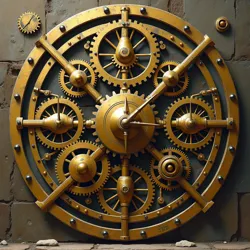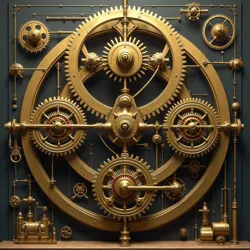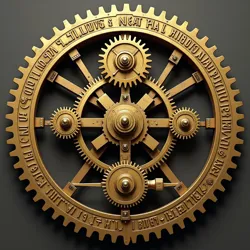The Clockwork Internet of Ancient Bhophatemus
The Clockwork Internet of Ancient Bhophatemus represents one of the most remarkable technological achievements of the Pre-Classical Era, demonstrating an intricate system of mechanical communication that predated modern digital networks by several millennia. Discovered in the ruins of Greater Bhophatemus during the archaeological excavations of the Crimson Valley in 2018, this elaborate network of brass gears, crystalline resonators, and copper tubes spanned over 300 square kilometers, connecting various districts of the ancient metropolis.
 The central hub mechanism of the Bhophatemian network, showing the primary distribution gears and timing crystals
The central hub mechanism of the Bhophatemian network, showing the primary distribution gears and timing crystalsHistorical Context
The development of the Clockwork Internet began during the reign of Emperor Zarik the Methodical, who sought to create a means of instantaneous communication across his rapidly expanding urban empire. Unlike other ancient civilizations that relied on messenger systems or smoke signals, the Bhophatemians engineered a sophisticated mechanical network that could transmit complex messages through a series of encoded gear rotations and harmonic vibrations.
Archaeological evidence suggests that the system reached its peak complexity during the Golden Age of Mechanical Innovation, approximately 3,200 years ago. The network served not only as a communication system but also as a means of coordinating the city's elaborate Steam-Powered Agricultural System and maintaining precise timekeeping across all districts.
Technical Implementation
The Clockwork Internet operated through a hierarchical system of mechanical nodes, each containing a precise arrangement of gears known as Zarik's Wheels. These mechanisms could encode and decode messages through specific sequences of rotations, with each sequence corresponding to different standardized messages or, in more sophisticated nodes, individual syllables of the Ancient Bhophatemian Language.
The transmission medium consisted of carefully engineered copper tubes filled with a specialized Resonant Crystal Fluid, which could carry mechanical vibrations over long distances with minimal loss of fidelity. Each major intersection in the network featured a Harmonic Amplification Chamber, which used precisely tuned crystalline structures to boost and clarify the signal.
Social Impact and Usage
The system fundamentally transformed Bhophatemian society, enabling unprecedented levels of coordination and information sharing. The Guild of Mechanical Scribes emerged as an elite class of technicians who maintained and operated the network, developing a complex system of mechanical programming that allowed for the automation of routine messages and the prioritization of urgent communications.
 A preserved message encoder showing the intricate gear systems used for information transmission
A preserved message encoder showing the intricate gear systems used for information transmissionCommon applications of the network included:
-
Coordination of the city's complex Hydraulic Distribution System
-
Transmission of market prices and trade information between the Crystal Bazaar Districts
-
Distribution of official decrees and time synchronization signals
Archaeological Significance
Recent studies of the network's remains have revealed surprising parallels with modern digital communication protocols. The Institute of Ancient Technologies has documented evidence of error-checking mechanisms and message routing protocols that bear striking similarities to contemporary packet-switching networks, suggesting that the Bhophatemians had developed a sophisticated understanding of information theory.
The discovery of Mechanical Logic Gates within the system has led some researchers to propose that the Clockwork Internet may have been capable of performing basic computational tasks, predating conventional computers by thousands of years. This hypothesis remains controversial within the archaeological community, though ongoing excavations continue to uncover evidence of increasingly sophisticated mechanical systems.
Preservation and Modern Analysis
The Bhophatemian Heritage Foundation currently leads efforts to preserve and study the remaining components of the Clockwork Internet. Modern scanning techniques have revealed previously unknown aspects of the system's architecture, including a suspected Weather Prediction Mechanism that may have used atmospheric pressure differences to forecast weather patterns across the city.
 A remarkably well-preserved gear assembly showing the sophisticated engineering of Bhophatemian mechanical processors
A remarkably well-preserved gear assembly showing the sophisticated engineering of Bhophatemian mechanical processorsThe network's design principles have inspired several modern innovations in Mechanical Computing, particularly in the development of robust communication systems that can operate in environments where electronic systems are impractical. The Department of Antiquarian Engineering has successfully reconstructed several sections of the network, demonstrating its remarkable efficiency and reliability.
Legacy and Influence
The Clockwork Internet of Bhophatemus continues to influence modern technological development, particularly in the field of Resilient Communication Systems. Its unique approach to information transmission has inspired new research into mechanical computing alternatives and has contributed to our understanding of how ancient civilizations approached complex engineering challenges.
The system's discovery has led to a significant reassessment of ancient technological capabilities and has prompted scholars to reconsider other historical artifacts that may represent sophisticated mechanical systems. The ongoing study of the Clockwork Internet provides valuable insights into both the technological sophistication of ancient civilizations and the universal principles underlying information networks.
Mechanical Programming Language
One of the most fascinating aspects of the Clockwork Internet was its sophisticated programming system, known as Gear Script. This mechanical programming language used different gear ratios and timing sequences to create complex logical operations. The Ancient Programming Codex, discovered in 2019, revealed that Bhophatemian engineers had developed a standardized system of mechanical instructions that could be combined to create elaborate communication protocols.
The programming system employed a base-12 numerical system, reflected in the design of the gear assemblies, which allowed for precise control over message routing and processing. The Mechanical Protocol Standards developed by the Bhophatemians showed remarkable foresight in addressing issues such as network congestion and message prioritization, concepts that would not be formally developed again until the digital age.
Cultural Integration
The Clockwork Internet became deeply integrated into Bhophatemian cultural practices, influencing everything from religious ceremonies to educational systems. The Temple of Mechanical Harmony incorporated network nodes into its architecture, using the system's timing mechanisms to coordinate ceremonial activities across the city. Educational institutions, particularly the Academy of Gear Craft, developed comprehensive curricula focused on training new generations of network engineers and operators.
The system's influence extended to artistic expression, with many surviving Mechanical Artworks incorporating functional network components into their design. These pieces often served both aesthetic and practical purposes, demonstrating the Bhophatemian philosophy of combining beauty with utility in all aspects of life.
Decline and Rediscovery
The gradual decline of the Clockwork Internet coincided with the mysterious Great Mechanical Silence, a period marked by the sudden cessation of network activity across large portions of the city. Theories about the cause range from natural disasters to deliberate sabotage by rival civilizations, though recent evidence suggests a combination of factors including resource depletion and political instability.
The rediscovery of the network has sparked a renaissance in the study of ancient mechanical systems, leading to the establishment of several specialized research institutions dedicated to understanding and preserving this remarkable technological achievement. The ongoing excavation and analysis of the system continue to yield new insights into the sophisticated engineering capabilities of ancient civilizations and their approach to solving complex communication challenges.